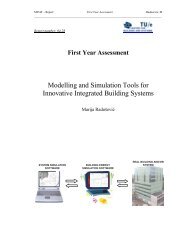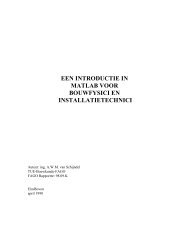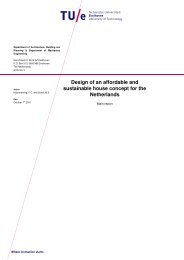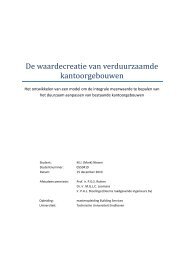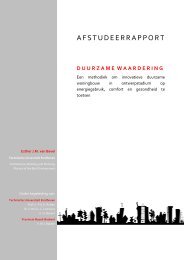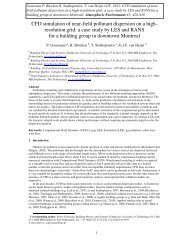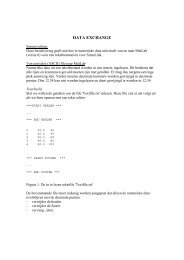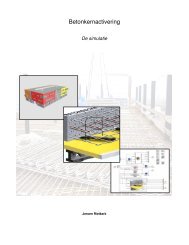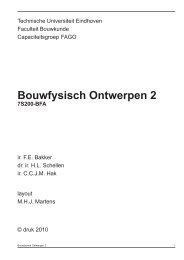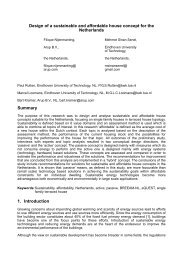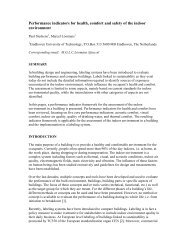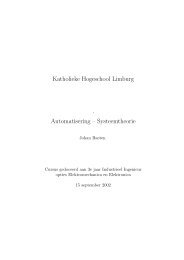Title of Contribution to ROOMVENT 2004
Title of Contribution to ROOMVENT 2004
Title of Contribution to ROOMVENT 2004
Create successful ePaper yourself
Turn your PDF publications into a flip-book with our unique Google optimized e-Paper software.
Thermal performance <strong>of</strong> a local bench heating system for churchesD. Limpens-Neilen 1 , M.E.A. Sch<strong>of</strong>felen 1 , H.L. Schellen 11 Eindhoven University <strong>of</strong> Technology, Department FAGO, Vertigo floor 6, P.O. Box 513, 5600 MB Eindhoven,The Netherlandsemail: d.neilen@bwk.tue.nl http://sts.bwk.tue.nl/friendlyheating/Summary: Within the European project “Friendly Heating” a local heating system is designed. The maingoal is not <strong>to</strong> heat the monumental churches themselves, in order <strong>to</strong> prevent damage <strong>to</strong> valuable art worksand the building itself. The idea is <strong>to</strong> provide a thermal comfort zone for the people in the pew usingradiant heat sources. Measurements in a climate room are used <strong>to</strong> a) evaluate the local climate created bythe bench heating system and b) evaluate the CFD model. The results will be used in ongoing research onthe prediction <strong>of</strong> the indoor climate in a church under real climate conditions.Keywords: local heating, measurements, CFD, thermal performanceSubject category: Indoor climate performance <strong>of</strong> buildings1 IntroductionThe problems <strong>of</strong> conservation, thermal comfortand the costs for heating in churches are still withouta common solution. Especially in churches that areused only once a week for liturgical celebrations, a lot<strong>of</strong> problems occur. In the first place, there areproblems concerning the conservation <strong>of</strong> the buildingand the artworks in it. Secondly, there is a problemwith the thermal comfort <strong>of</strong> the people. And there arealso the large costs for heating the church.When the church is heated, the heated air rises up<strong>to</strong>wards the vault, introducing a warm zone in theupper part <strong>of</strong> the church, while the area where thepeople are seated remains relatively cold. This meansthat there are large heating costs, while the people stillcomplain about the temperature being <strong>to</strong>o low.From the point <strong>of</strong> view <strong>of</strong> limiting the heatingcosts, church boards prefer <strong>to</strong> heat the indoor airrapidly, which introduces abrupt variations in theindoor climate. These variations in temperature andrelative humidity (H) mostly are the main cause <strong>of</strong> theproblems with the conservation <strong>of</strong> artworks and otherinterior parts <strong>of</strong> monumental churches [1], [2].Within the European Project “Friendly Heating” anew heating system is being designed. This novelheating system is intended <strong>to</strong> provide people withthermal comfort and, at the same time, <strong>to</strong> avoid anyrisk on damaging artworks preserved in churches. It isa local bench heating system that provides the hea<strong>to</strong>nly where it is needed. The case study for thisEuropean project is the church <strong>of</strong> Rocca Pie<strong>to</strong>re in theItalian Dolomites where the pro<strong>to</strong>type <strong>of</strong> the heatingsystem is installed [3].The main goal <strong>of</strong> this research is <strong>to</strong> study thethermal performance <strong>of</strong> the local heating system,regarding both conservation criteria and thermalcomfort. The first part <strong>of</strong> the research, which ispresented in this paper, is <strong>to</strong> perform referencemeasurements on the pews equipped with the heatingsystem in a climate room under steady conditions.The results <strong>of</strong> these measurements will be used forverification <strong>of</strong> the computer simulations on the sameclimate room set-up. The main question is how <strong>to</strong>model the local heating systems that are applied in thebenches. To answer this question, we must know theinfluence <strong>of</strong> heating system on the local climate in thepews, i.e. what changes in temperatures and airvelocities are introduced?Later on, the effect <strong>of</strong> the heating system on theoverall climate in a church can be investigated withregard <strong>to</strong> the conservation criteria.2 Local bench heating systemAs mentioned before, a local bench heating systemis applied in the church <strong>of</strong> Rocca Pie<strong>to</strong>re, Italy. Thislocal system aims <strong>to</strong> warm the people in the pews,with a minimum influence on the rest <strong>of</strong> the church.For this goal, radiant heating is the most appropriatebecause the heat is radiated straight <strong>to</strong>wards thepeople without a large effect on the environment. Butsimultaneous kinds <strong>of</strong> heat transfer (convection andconduction) should always be taken in<strong>to</strong> account.The heating elements used in this research consist<strong>of</strong> two types <strong>of</strong> electrical heat sources: heating foiland resistance cables. The heating foil (Thermotex)consists <strong>of</strong> glass fabrics that are impregnated withelectrical conducting plastics "PTFE-Carbon". Tinplated copper foils are stitched <strong>to</strong> the edges <strong>of</strong> theheating foil as bus bars. The electrical insulation isobtained by laminating a compound <strong>of</strong> polyester/polyethylene foils. This heating foil, with a powersupply <strong>of</strong> 220V, is used in the elements that areapplied in the back and under the seat <strong>of</strong> the pew.Figure 1 shows the heating systems that areapplied in the pews.
sheet. The sheet is heated and then radiates <strong>to</strong> thewooden floorboard and the people’s feet that areplaced beneath the kneeler pad.Figure 1. Heating elements applied in the pew2.1 Seat heating elementBack heatingSeat heatingKneeler PadheatingThe heating element that is applied under the seatis a semicircular element, with heating foil as the heatsource, which is designed <strong>to</strong> radiate heat <strong>to</strong> people’slegs. In order <strong>to</strong> prevent overheating the seat, whichcan cause the wood <strong>to</strong> crack, insulation is appliedbehind the heating foil. So the heat is only radiated <strong>to</strong>the wooden floorboard and <strong>to</strong> the front and back <strong>of</strong>the pew. In order <strong>to</strong> protect the heating foil, it iscovered with a perforated metal grid that is kept at adistance <strong>of</strong> 1 cm from the foil with help <strong>of</strong> spacers.The perforation rate <strong>of</strong> the metal grid is 50% so the IRradiation from the heating foil can reach the peopledirectly.In one pew, two <strong>of</strong> these heating elements areapplied, each with an electrical load <strong>of</strong> 155W. Thespecifications are presented in table 1.2.3 Back heating elementIn the back heating element, the heating foil iscovered on both sides (back and front) with theperforated metal grid that is mentioned before. Themetal grid in this heating element is also kept at adistance <strong>of</strong> 1 cm from the foil using spacers. Theheating element is attached between the back and theseat; in fact it closes the back <strong>of</strong> the pew.In each pew, one back heating element is appliedwith an electrical load <strong>of</strong> 370W.3 Climate room set-upThe measurements discussed in this paper wereused as input parameters for the boundary conditions<strong>of</strong> the CFD model. Secondly, these results will beused for the verification <strong>of</strong> the simulation results.Eventually, the heating system that will be used in thechurch pews will consist <strong>of</strong> a combination <strong>of</strong> heatingelements. But <strong>to</strong> study the effects <strong>of</strong> each heatingelement on its environment, all measurements wereperformed on one type <strong>of</strong> heating element in a steadystate indoor environment. This environment wascomposed in the climate chamber <strong>of</strong> the EindhovenUniversity <strong>of</strong> Technology.2.2 Kneeler pad elementThe heating element that is applied beneath thekneeler pad consists <strong>of</strong> a resistance wire (RaychemElectromelt EM2-R) that is double folded. Theresistance <strong>of</strong> the wire increases when the temperature<strong>of</strong> the wire increases. Therefore the wire has a peakload <strong>of</strong> 970W right after switching on the power anddecreases <strong>to</strong> 130W when the equilibrium temperatureis reached after about 3 minutes. To preven<strong>to</strong>verheating the kneeler pad, which can damage thewood, insulation is applied between the electricalresistance wire and the kneeler pad. This combination<strong>of</strong> insulation and heating wire is covered with a metalFigure 2. Overview <strong>of</strong> climate room with the benchesTable 1. Overview <strong>of</strong> the heating systemsHeatingelementShape Protective cover <strong>of</strong>the elementHeat sourceseat semicircular metal grid,50% openback rectangular metal grid,50% openKneeler rectangular metal sheet Electricalpadresistance wireLength[m]Width[m]Height[m]ElectricalPower[W]#per pewElectrical foil 0.99 Radius = 0.11 155 2Electrical foil 2.00 0.02 0.35 370 12.00 0.09 0.02 130(start peak 970W)1
In this climate room - see figure 2 for thedimensions - a measurement set-up was built aroundthree church pews in which the local heating elementswere applied. The heating elements could be operatedseparately.The heating elements were turned on for 75minutes: it <strong>to</strong>ok 15 minutes for the system <strong>to</strong> heat up,after that the measurements continued for 60 minuteswhich is about the duration <strong>of</strong> a service. During thesemeasurements, the wall, ceiling and floortemperatures were kept at a temperature <strong>of</strong> around6°C. The idea behind this temperature was <strong>to</strong> createan indoor climate that represents the average indoorclimate <strong>of</strong> the church <strong>of</strong> Rocca Pie<strong>to</strong>re in theDolomites (northern Italy) during winter.4 Measurement methods4.1 Infrared thermographyInfrared thermography is an appropriate method <strong>to</strong>measure surface temperatures, but not for measuringair temperatures. Because an impression <strong>of</strong> both airand surface temperatures was desired, paper stripswere fixed <strong>to</strong> the ceiling, which enabled us <strong>to</strong> measurethe temperature <strong>of</strong> the paper. This temperaturerepresents a combination <strong>of</strong> the local air temperatureand the radiant temperature. Due <strong>to</strong> its low heatcapacity, paper is suitable for this. Paper strips instead<strong>of</strong> a paper plane are used in order <strong>to</strong> avoid extremedisturbance <strong>of</strong> the air movement.4.2 Local climateAt first, infrared thermographic pictures weretaken in the climate room. After that, smoke testswere performed <strong>to</strong> visualize the airflow around thebenches and the heating system. Those two kinds <strong>of</strong>measurements gave a first impression <strong>of</strong> the influence<strong>of</strong> the local heating system on the temperaturedistribution and air movements between the benches.Figure 3. Measurement grid applied in the plane cutThe positions <strong>of</strong> the temperature sensors as well as theair velocity sensors were determined on the basis <strong>of</strong>these measurements. The measurements on the localclimate at different locations in a plane cut wereperformed for each heating system. A measuring gridwas applied <strong>to</strong> this plane cut, see figure 3. (The blackplane is only applied for making the measuring gridvisible on the picture). The air temperature wasmeasured at 16 positions on the measuring grid usingNegative Temperature Coefficient (NTC) sensors.The surface temperature was also measured usingNTCs at 24 positions. Squirrel data loggers wereapplied <strong>to</strong> register the output <strong>of</strong> these sensors. AllNTCs were positioned in a way that the influence <strong>of</strong>direct radiation effects was minimized. The airvelocities and turbulence intensities were measuredusing hot sphere anemometers. A configuration thatwas made with a 3-channel Input Module and an A/Dconverter, allowed a simultaneous 10Hz samplingfrequency and s<strong>to</strong>rage <strong>of</strong> the bridge voltage output forall anemometers. The anemometers were placed at the8 most important positions, determined on the basis <strong>of</strong>the performed smoke tests. The hot sphereanemometers were calibrated using the calibrationmethod described by Loomans [4],[5].Figure 4. IR thermograph <strong>of</strong> the bench with the heatingsystem under the seat turned on.Figure 5. Air flow between the benches with the heatingsystem under the seat turned on.
Figure 6. Air and surface temperatures with seat andkneeler pad heating system operating6 CFD SimulationsThe set-up <strong>of</strong> the benches with the local heatingsystem in the climate room is modelled in the CFDpackage Fluent, version 6.1 [5]. In the simulationmodel the standard k-ε model is applied with thestandard wall functions. In this model a structural gridis applied with grid cells that grow from the areaaround the benches <strong>to</strong>wards the boundaries <strong>of</strong> theroom. The room boundary conditions like wall,ceiling and floor surface temperatures as well as theinitial surface temperatures <strong>of</strong> the benches werederived from the measurements in the climate room.A first simulation <strong>of</strong> the seat heating system isperformed.6.1 EvaluationThe first simulation results were evaluated withhelp <strong>of</strong> the measurements discussed before. Thisevaluation showed that the surface temperatures <strong>of</strong> thebenches (see figure 6) were in good agreement withthe measurements (figure 4). These figures show thesame temperature distribution on the wooden benchesand the heating system.The next step in this research is <strong>to</strong> investigatewhat kind <strong>of</strong> viscous model should be used <strong>to</strong> achievean accurate CFD simulation <strong>of</strong> the local climatebetween and around the benches.The results <strong>of</strong> this evaluation will be used <strong>to</strong>determine the parameters that are important as inputfor the simulations. First, this will be used forperforming simulations under the steady conditions <strong>of</strong>the climate room. In ongoing research, these resultswill be used for modelling and performing CFDsimulations <strong>of</strong> the situation in a church under realclimate conditions.7 ConclusionsFrom the measurements that have been performedin this research, the influence <strong>of</strong> the different heatingelements on the local climate in and around thebenches has become clear. The heating elementsunder the seat and in the back have the largestinfluence on this local climate. The air temperaturesbetween the benches increased up <strong>to</strong> 4°C, while atsome positions a maximum increase in surfacetemperatures <strong>of</strong> 10°C was measured. The mostimportant region <strong>of</strong> impact for air velocities is foundat shoulder height. The influence <strong>of</strong> the heatingelement under the kneeler pad is limited <strong>to</strong> the regionadjacent <strong>to</strong> this element.The first simulation results <strong>of</strong> the seat heatingsystem are in good agreement with the results <strong>of</strong> thesmoke tests and the infrared thermographic pictures,which give a general impression <strong>of</strong> airflows andtemperature distribution. For a more detailedverification, the temperatures and air velocitiesmeasured on the different positions can be used.In ongoing research this verification will beperformed for the two other heating systems. Afterthat, the model can be upgraded <strong>to</strong> the real situation inthe church building with the actual outdoor climateconditions.AcknowledgementsThe work presented in this paper is part <strong>of</strong> theEuropean project “Friendly Heating” which is fundedby the European Commission in the 5 th FrameworkProgram under contact no: EVK4-CT-2001-00067.The authors would like <strong>to</strong> acknowledge the financialsupport they have received from the EuropeanCommission.References[1] Schellen, H. L., 2002: Heating monumentalchurches: indoor climate and preservation <strong>of</strong>cultural heritage. Dissertation EindhovenUniversity <strong>of</strong> Technology, The Netherlands.ISBN: 90-386-1556-6[2] Arendt, Claus, 1993: Raumklima in grossenhis<strong>to</strong>rischen Raümen: Heizungsart,Heizungsweise, Schadensentwicklung,Schadensverhinderung. ISBN: 3-481-00564-4[3] www.isac.cnr.it/friendly-heating[4] Loomans, M.G.L.C, 1998: The measurement andsimulation <strong>of</strong> indoor airflow. DissertationEindhoven University <strong>of</strong> Technology, TheNetherlands. ISBN: 90-6814-085-X[5] Loomans, M.G.L.C.; Schijndel, A.W.M. van,1998: Simulation and measurement <strong>of</strong> thestationary and transient characteristics <strong>of</strong> the hotsphere anemometer. Eindhoven University <strong>of</strong>Technology, The Netherlands, FAGO report98.08.K[6] Fluent Inc., Fluent User’s Guide, version 6.1,Lebanon, USA, February 2003



